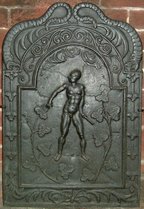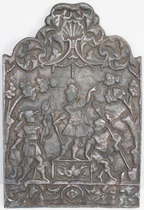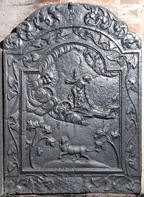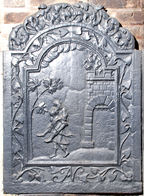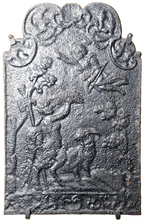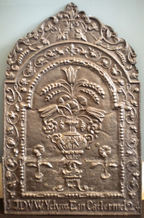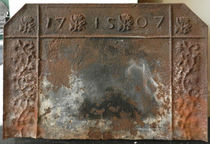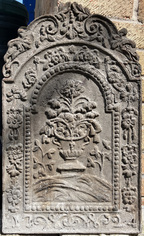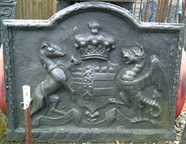-
500
Description: Arched rectangular shaped central panel with astragal and fillet edge, pictorial, a bald, naked man, standing on a mound, holding a baton in his left hand, surrounded by leaf fronds to left and right, and clouds above; arched rectangular shaped border, fillet edging, hanging leaf clusters to left and right, swirled lines above, and draped foliage with monogram at base; on top are two serpents and draped foliage.
Notes: The figure may represent Pheidippides, the messenger between Athens and Sparta during the Battle of Marathon in 490BC.
Copies of this fireback are known.
Inscription: TAN
- Decoration tags:
- 'Dutch' (shape)
- fillet (edging)
- whole carved pattern
- pictorial
- mythological
- monogram
- text
- humans
Manufactured: in the early-18th century probably at Ashburnham Furnace in the Weald area of England.
Current location: West Berkshire Museum, Newbury, Berkshire, England.
Citation: Lloyd, N., 1925, 'Domestic Ironwork I', Architectural Review, 58, pp. 58-67.
- Attached to series:
- TAN series
- British 'Dutch' style firebacks
-
211
Description: Rectangular with arched, mirrored, scrolls on top, a cartouche scallop shell between; fillet edging; between two trees, three soldiers in Roman dress, holding either pikes, swords or shields, one on a plinth; at the bottom, a separate rectangular panel with mirrored scrolled foliage.
Notes: Possibly intended to represent the Horatii who, according to Livy, defeated the Curiatii.
Copies of this fireback are known.
- Decoration tags:
- rectangular with ornate arch (shape)
- fillet (edging)
- whole carved pattern
- pictorial
- mythological
- humans
Manufactured: in the early-18th century in England.
Current location: Kernow Furniture, Penhalvean Pottery, Penhalvean, Cornwall, England.
- Attached to series:
- Late pictorial series (all)
- Late pictorial series 4
-
509
Description: Arched rectangular central panel with astragal and fillet edging; Phaëton riding Apollo’s chariot across the skies, the sun to the left behind clouds, a lion on ground below, between two trees; arched rectangular border with fillet edging; trailing convolvulus leaves surround the central panel; on top, earl’s coronet above an illegible character, between mirrored, swirled foliage.
Notes: The illustration upon which the design has been based has not been identified, save that it figures in book II of Ovid's Metamorphoses. The convolvulus border is a common feature of this series of firebacks and can be compared with other. The wooden pattern from which this casting was made survives in the collection of the Sussex Archaeological Society (no. 928).
- Decoration tags:
- 'Dutch' (shape)
- fillet (edging)
- whole carved pattern
- planklines
- pictorial
- mythological
- animals
- humans
- objects
Manufactured: in the early-18th century at Ashburnham Furnace in the Weald area of England.
Current location: Penhurst Manor, Penhurst, East Sussex, England.
- Attached to series:
- TAN series
- British 'Dutch' style firebacks
-
510
Description: Arched rectangular central panel with astragal and fillet edging; to the left, Æneäs carrying his father, Anchises; to the right, an arched gateway and portcullis beneath battlements with flames rising therefrom; above left, clouds; far left, a tree; arched rectangular border with fillet edging; trailing convolvulus leaves surround the central panel; plain rectangular extensions to the bottom and each side; on top, mirrored, swirled foliage.
Notes: Many of the early illustrated editions of Ovid’s Metamorphoses show Æneäs escaping from burning Troy, with his father on his back, most of them with an archway in the background.
Copies of this fireback are known.
Inscription: TAN
- Decoration tags:
- 'Dutch' (shape)
- fillet (edging)
- whole carved pattern
- planklines
- extension panels
- pictorial
- mythological
- architectural
- monogram
- text
- humans
Manufactured: in the early-18th century at Ashburnham Furnace in the Weald area of England.
Current location: Penhurst Manor, Penhurst, East Sussex, England.
- Attached to series:
- TAN series
- British 'Dutch' style firebacks
-
548
Description: Arched rectangular central panel with bead edging; female figure, a crown above her head, holding two snakes; arched rectangular border with fillet edging; top centre, knot of ribbon with festoons of pomegranates suspended therefrom via a ring on each shoulder of the plate; at the bottom, two crossed palm fronds; on top, symmetrical arrangements of swirled foliage; on each side, a plain rectangular panel with fillet edging.
Notes: Possibly the allegorical figure of Democracy; the form of the palm fronds and the swirled foliage on top suggest a common pattern-maker with the TAN series and the Mayfield 'Dutch' series. Mitford collection, Petworth House.
- Decoration tags:
- 'Dutch' (shape)
- fillet (edging)
- whole carved pattern
- extension panels
- pictorial
- allegorical
- humans
Manufactured: in the early-18th century in England.
Current location: Petworth House, Petworth, West Sussex, England.
Museum number: NT/PET/M/102 (part of the National Trust museum group)
- Attached to series:
- British 'Dutch' style firebacks
- TAN series
-
521
Description: Rectangular with arched, mirrored scrolls on top and central scallop shell; fillet edging; Pan, with a goat behind, trees to left and right; a putto above right; at the bottom, a separate rectangular panel with mirrored scrolled foliage.
Notes: A scene apparently unrelated to a specific classical narrative, and without the customary decorated border. Mitford collection, Petworth House.
Copies of this fireback are known.
- Decoration tags:
- rectangular with ornate arch (shape)
- fillet (edging)
- whole carved pattern
- pictorial
- mythological
- animals
- humans
- plants
Manufactured: in the early-18th century in England.
Current location: Petworth House, Petworth, West Sussex, England.
Museum number: NT/PET/M/75 (part of the National Trust museum group)
- Attached to series:
- Late pictorial series (all)
- Late pictorial series 2
-
885
Description: Arched rectangular shaped central panel, bead-and-pellet edging, narrow-necked, two-handled urn with flowers and wheat ears issuing therefrom, the vase resting on a wall with stone courses, against which are two small flowers in pots with a stool between; arched rectangular shaped border with fillet edging and symmetrical floral tendrils, a looped 'W' in each shoulder; on top, mirrored leaves, tendrils and wheat ears; inscription along bottom of border.
Notes: One of the two largest of six flower vase designs in this series (see also no. 858). All incorporate the looped 'W' motif which may be intended to identify the pattern maker. The casting is an amalgamation of parts of two firebacks of the same design, the bottom portion from an earlier casting than the top (reduction 2%). The inscription translates as 'God is our strength'.
Inscription: 17 DVW Ydyw Ein Cadernid 24
Manufactured: in 1724 in England.
Current location: not known.
- Attached to series:
- 1724 series
- British 'Dutch' style firebacks
- Welsh inscription series
-
910
Description: Canted rectangle; cavetto-moulded edging (top and sides); single horizontal fillet below canted corners and vertical fillet parallel to each side, dividing the fireback into two side panels, two top corner panels, top panel and main central panel; corner panels, ‘daisy’ plant stamp; top panel, central initials between split date, separated by 'daisy' stamps; side panels, swirling foliage stamp repeated each side, initial at bottom of panel: I to the left, B to the right.
Notes: The 'daisy' stamp and the IB initials are found on other backs in a distinct series. The foliage stamp is not known on other backs in the series. Christie's Interiors - Masters & Makers (Sale 5462), South Kensington, London, 8 July 2014, lot 126 (£688).
Inscription: 17 IS 07 / I B
- Decoration tags:
- rectangular with canted top corners (shape)
- cavetto (edging)
- carved stamps
- individual letters
- individual numbers
- text
- plants
Manufactured: in 1707 in the Forest of Dean area of England.
Current location: not known.
- Attached to series:
- IB series
- Date & initials firebacks
-
549
Description: Arched rectangular shaped central panel, bead on fillet edging, narrow-necked urn with flowers issuing therefrom; arched rectangular shaped border with fillet edging and symmetrical floral festoons; on top, stylised fish with floral accessories; at bottom, two looped 'W' figures between date split between bottom corners.
Notes: The smallest of six flower vase designs in this series. All incorporate the looped 'W' motif which may be intended to identify the pattern maker. The small size of this fireback makes it likely that it was intended to be fixed to the back of a grate. Reeman Dansie auction, Colchester, 30 Sep 2025, lot 5292 (£46).
Copies of this fireback are known.
Inscription: 17 24
Manufactured: in 1724 in England.
Current location: not known.
- Attached to series:
- 1724 series
- British 'Dutch' style firebacks
-
596
Description: Arched rectangular shape with base plinth; astragal and fillet edging (top and sides) with overlapping leaf pattern; mirrored wave pattern on plinth; shield, supporters, motto scroll and coronet of the 1st Earl of Ashburnham.
Notes: The arms are Ashburnham impaling Grey: Ashburnham: quarterly 1. Ashburnham - gules a fess between six mullets argent; 2. Holland - azure semee of fleurs-de-lys a lion rampant guardant argent; 3. Kenn - ermine three crescents gules; 4. Vaughan - sable a fess argent between three boys' heads couped at the shoulders proper having snakes enwrapped about their necks vert; and Grey - barry of six argent and azure in chief three torteaux. John, 3rd Baron Ashburnham, married Lady Jemima Grey in 1724. He was created Earl of Ashburnham in 1730 so the fireback probably dates between then and 1731 when Lady Ashburnham died. A sketch of an example of this fireback was made by J. Starkie Gardner c.1891 and is in his collection at the Victoria and Albert Museum, Archive of Art and Design (AAD/2014/8).
Copies of this fireback are known.
Inscription: LE ROY ET L'ESTAT [barely legible]
Arms: John, 1st Earl of Ashburnham
- Decoration tags:
- rectangular with round arch (shape)
- astragal & fillet (edging)
- whole carved pattern
- armorial
Manufactured: in the early-18th century probably at Ashburnham Furnace in the Weald area of England.
Current location: Mark Ripley Forge & Fireplaces, Northbridge Street, Robertsbridge, East Sussex, England.
Citation: Denny, H., 1937, 'Iron Fire-back', Sussex Notes and Queries, 6, 6, p. 189.
- Attached to series:
- Ashburnham family firebacks
- Personal armorial firebacks
